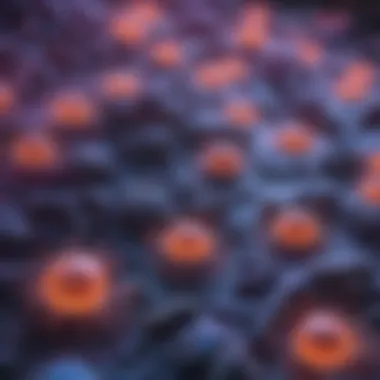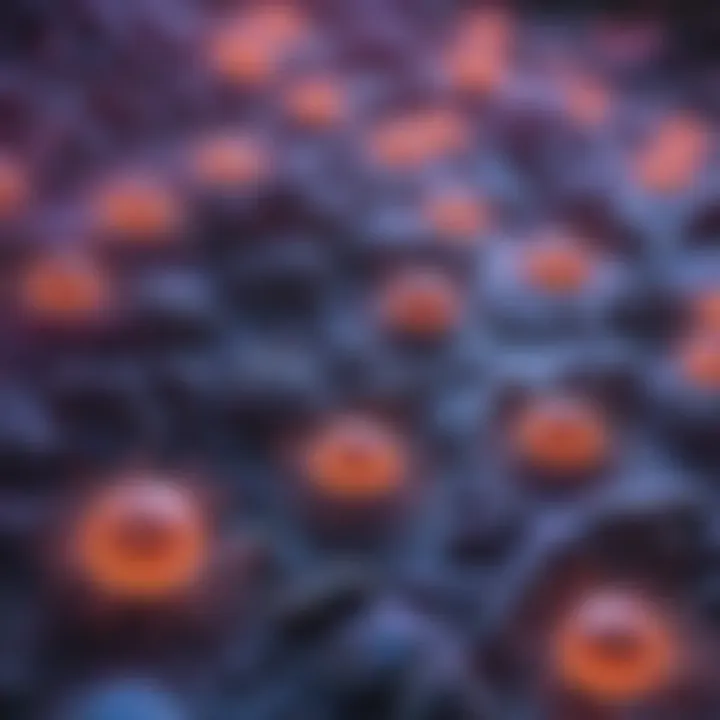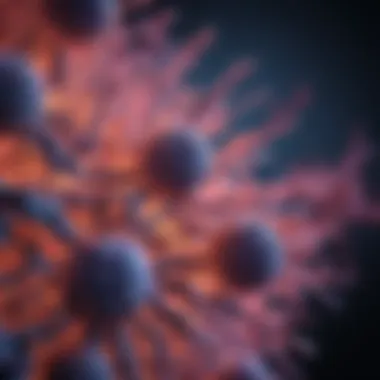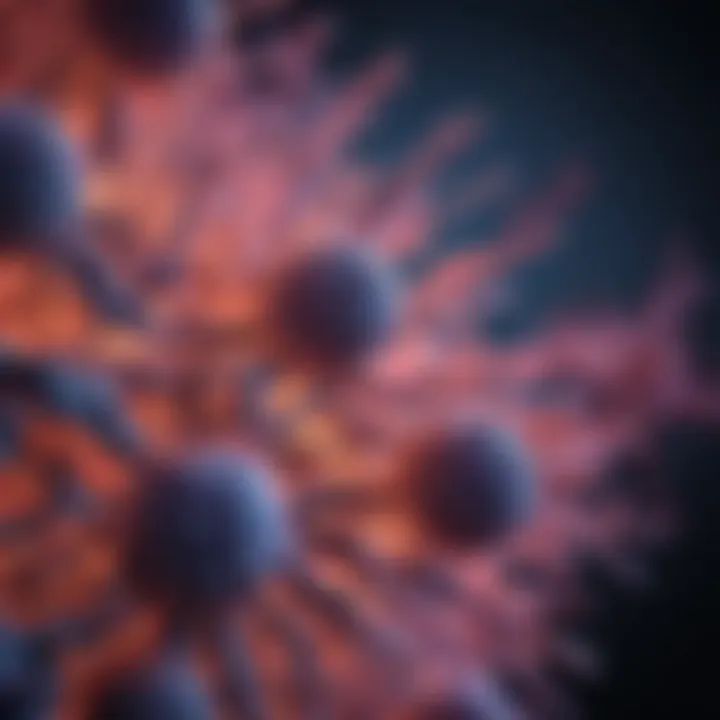Exploring Germicidal UV Wavelengths: Applications & Science


Intro
As the world grapples with increasing public health challenges, the quest for effective sanitation technologies has become more crucial than ever. Among these technologies, germicidal ultraviolet (UV) light has risen to prominence. This section serves to introduce the underlying principles of germicidal UV light and its applications in various domains.
UV light is divided into three main bands: UVA, UVB, and UVC. It is the UVC band, specifically wavelengths between 200 to 280 nanometers, that exhibits potent germicidal properties. Microbial inactivation occurs through the absorption of UV light by the DNA and RNA of microorganisms, which ultimately leads to cell death or impaired replication capabilities. This mechanism underscores the significance of this technology in fields such as healthcare, water treatment, and air purification. Understanding how these wavelengths work will enable researchers and practitioners to utilize germicidal UV effectively in their practices while assuring safety and efficiency.
Key Findings
Germicidal UV light has shown remarkable effectiveness in various applications.
Individuals in healthcare settings utilize it for disinfecting surfaces and medical equipment systematically. Additionally, water treatment facilities have integrated UV technology to eliminate pathogens without the introduction of harmful chemicals. In the realm of air purification, specialized UV systems facilitate the reduction of airborne microbes.
Notably, these applications highlight the versatility of germicidal UV wavelengths and their potential for safeguarding public health.
Major Results
Research has demonstrated that UVC light significantly reduces the infectious load of common pathogens, including bacteria and viruses. Laboratory studies have indicated that exposure to UV-C light can inactivate up to 99.9% of organisms such as
- Staphylococcus aureus
- Escherichia coli
- Influenza viruses
This high efficacy positions germicidal UV as a vital tool in infection control measures and proactive sanitization efforts.
Discussion of Findings
The implications of these findings extend beyond mere effectiveness. Safety is a critical concern when deploying UV technology. Proper protocols must be established to protect human health during its application. Current research emphasizes the necessity for shielding and automatic shutoff features in UV devices, ensuring that exposure to harmful UVC radiation is minimized. Collaboration between scientists, manufacturers, and regulatory bodies can facilitate the responsible rollout of these systems.
Methodology
To provide a comprehensive overview of the subject, a systematic approach was utilized in analyzing existing literature and field studies regarding germicidal UV wavelengths.
Research Design
The research design involved a meta-analysis of studies that focus on germicidal UV light applications. It included both qualitative and quantitative data to determine efficacy across different contexts.
Data Collection Methods
Data was collected from reputable sources, including scientific journals, clinical studies, and environmental health reports. These sources offered a broad understanding of how germicidal UV wavelengths impact various microbial species and their role in public health strategies.
Overall, the investigation of germicidal UV is not only scientifically significant but also replete with societal implications.
Prologue to Germicidal UV Light
The topic of germicidal UV light is pivotal in understanding modern disinfection strategies. These methods harness specific wavelengths of ultraviolet light that are effective in eliminating harmful microorganisms. As concerns about public health increase, the need for reliable germicidal solutions becomes even more crucial. Germicidal UV light offers a promising approach for sanitization across various domains, including healthcare, water treatment, and air purification.
Definition and Overview
Germicidal UV light specifically refers to ultraviolet light in the UVC range, typically between 200 to 280 nanometers. This subsection will clarify that UVC wavelengths disrupt the DNA or RNA of microorganisms, preventing them from reproducing and effectively inactivating them. The importance of understanding this distinct form of UV light cannot be overstated, as it underpins many of today's disinfecting technologies. By scientifically analyzing germicidal properties, researchers and professionals can implement effective disinfection protocols that ensure safer environments.
Historical Context
The concept of germicidal UV light is not new. It has roots tracing back to the early 20th century. Scientists began to recognize the potential of UV light for sterilization and disinfection. In the 1900s, UV light was utilized in hospitals to reduce infection rates among patients. As technology advanced, the application of UV for water purification emerged, with municipalities adopting this method to ensure clean drinking water. By examining the historical context, we see a clear evolution in the understanding and adoption of UV technology within various sectors. The ongoing research into more effective and safe applications of germicidal UV shows that this field remains active and relevant today.
"Germicidal UV light has transformed many industries by making disinfection faster and more efficient."
In summary, germicidal UV light represents a vital tool in current sanitization efforts. Its historical significance, coupled with modern advancements, highlights not only its importance for safety but also its application across diverse fields of public health and environmental protection.
Understanding UV Light
Understanding ultraviolet (UV) light is fundamental in the exploration of germicidal applications. It is crucial to grasp how UV light operates within the electromagnetic spectrum. This contributes to the comprehension of its effectiveness in microbial inactivation. Knowledge of UV light benefits various fields, including healthcare, environmental science, and public safety.
The Electromagnetic Spectrum
Ultraviolet light is a part of the electromagnetic spectrum, which includes a range of wavelengths from radio waves to gamma rays. UV light lies between visible light and X-rays. The spectrum is categorized by wavelength. Generally, UV light is divided into three primary regions:
- UVA (315-400 nm): This is the longest wavelength of UV light. UVA penetrates deeply into the skin and has various applications ranging from tanning to curing plastics.
- UVB (280-315 nm): UVB has a shorter wavelength than UVA. It is known for its role in causing sunburn and its importance in vitamin D synthesis.
- UVC (100-280 nm): This is the shortest and most energetic UV wavelength. UVC is efficient for germicidal activities. It effectively destroys the DNA of microorganisms.


The significance of UVC in germicidal applications cannot be overstated. Its ability to kill microorganisms supports its use in disinfection technologies.
Classification of UV Light
Classifying UV light is vital for understanding its effects and applications.
- Germicidal UV (GUV): This classification includes UVC wavelengths that are most effective at inactivating bacteria, viruses, and other pathogens. It is specifically relevant in sanitization processes.
- Therapeutic UV: This refers to the use of UVA and UVB light in treating skin disorders. Dermatology uses these wavelengths for treatments like psoriasis and eczema.
- Photochemical UV: This classification involves UV light's role in chemical reactions, essential in various industrial processes.
Recognizing these classifications helps in the safe and effective utilization of UV light in different fields. With a proper understanding of UV light and its classifications, advancements in germicidal technologies stand to significantly improve public health and sanitation efforts around the globe.
Germicidal Wavelengths
Germicidal wavelengths are crucial in the context of ultraviolet (UV) light as they play a significant role in the inactivation of microorganisms. Understanding these wavelengths allows researchers and practitioners to effectively harness their properties for disinfection and sanitization purposes. Among the various segments of UV light, the UVC range is recognized for its potent germicidal abilities, making it a focal point in many applications involving health and safety.
One of the primary benefits of utilizing germicidal wavelengths is their efficiency in destroying bacteria, viruses, and fungi. This makes them valuable in environments where hygiene is paramount, such as hospitals, laboratories, and food processing facilities. The ability of these wavelengths to target and destroy the genetic material of pathogens means they can significantly reduce infection rates and enhance the overall safety of a given space.
However, considerations regarding the use of these wavelengths are also vital. While UVC light can effectively eliminate germs, it can also pose risks to human health. Prolonged exposure to UV radiation can lead to skin burns and eye damage. Therefore, it is essential to implement protective measures and adhere to guidelines during deployment. A well-designed system that uses germicidal wavelengths should maximize efficacy while mitigating risks to human operators.
In summary, germicidal wavelengths represent a scientifically-backed method of microbial control. Their application ranges broadly across different fields, supported by evolving technologies that enhance safety and effectiveness.
UVC Range
The UVC range refers to wavelengths from 100 to 280 nanometers. This segment of UV light is particularly effective for disinfection because it disrupts the DNA or RNA of microorganisms, preventing them from replicating and rendering them inactive. For instance, wavelengths around 254 nanometers are frequently employed in germicidal lamps and have been shown to achieve a high rate of microbial inactivation.
The effectiveness of UVC light has been studied extensively, confirming its superiority over UVA and UVB in terms of germicidal properties. In laboratory settings, researchers have documented that UVC exposure can eliminate over 99% of various pathogens, depending on the dose and exposure time. This capability illustrates UVC’s critical role in modern disinfection strategies.
"UVC light is a powerful tool in the fight against infectious diseases, especially when used correctly and within specified safety measures."
In practice, UVC technology has found various applications, from portable devices used for surface disinfection to large-scale systems in healthcare facilities. Its adaptability makes it a valuable asset in public health initiatives aiming to control the spread of infectious diseases.
Comparison with UVA and UVB
When comparing UVC with UVA and UVB wavelengths, distinct differences in their biological effects and applications become apparent. UVA, which ranges from 320 to 400 nanometers, is mostly known for its role in skin aging and tanning, but it has a limited germicidal effect. UVA penetrates deeper into the skin than UVC but does not effectively eliminate microorganisms.
UVB wavelengths fall between 280 to 320 nanometers and are more germicidal than UVA but less effective than UVC. UVB radiation is primarily responsible for causing sunburns and has a limited application in disinfection due to its lower efficacy in inactivating pathogens.
In summary:
- UVC: Most effective for disinfection, targeting microorganisms efficiently.
- UVB: Moderately effective; primarily associated with skin damage and less germicidal than UVC.
- UVA: Least effective for microbial inactivation, primarily impacts skin health.
This differentiation not only helps in understanding the mechanisms involved but also guides the selection of the right type of UV light for specific disinfection needs. It is imperative for professionals in relevant fields to fully grasp these distinctions to optimize germicidal practices.
Mechanisms of Microbial Inactivation
Understanding the mechanisms of microbial inactivation is crucial for effectively utilizing germicidal UV technology. These mechanisms explain how UV light, especially in the germicidal UVC range, disrupts microbial life. Rational comprehension of these processes allows for precise applications in various fields, including healthcare and water sanitation. Increased awareness about mechanisms can enhance the design of systems that apply UV light, ensuring maximal efficacy in disinfecting surfaces, air, and water.
DNA Damage Processes
Germicidal UV light primarily acts by causing damage to the DNA of microorganisms. When DNA absorbs UV light at specific wavelengths, usually around 254 nanometers, it leads to the formation of pyrimidine dimers. These dimers are covalent linkages between adjacent thymine or cytosine bases in the DNA strand. This structural alteration prevents proper DNA replication and transcription, leading to lethal mutations that are often irreversible. Consequently, the cell is unable to carry out essential functions, resulting in cell death.
Moreover, different species react variably to UV exposure, depending on their DNA repair capabilities. Some microorganisms, like certain bacteria, possess sophisticated mechanisms to repair DNA damage. However, with sufficiently intense UV exposure, even these organisms can succumb to the induction of unmanageable errors in genetic material. Through careful calibration of UV doses, disinfection protocols can be optimized to mitigate bacterial resistance in a healthcare setting or throughout wastewater treatment processes.
Cellular Responses to UV Exposure
Upon exposure to UV light, microorganisms exhibit various cellular responses, which further elucidate the inactivation process. The initial reaction often involves the induction of stress responses. Cells may attempt to activate repair mechanisms or enter dormant states in an attempt to survive. For instance, the SOS response is a well-documented pathway activated in bacteria when substantial DNA damage is detected. The SOS response can lead to the expression of genes that allow for damaged DNA repair or activate mechanisms to resist UV damage.
However, this cellular reaction is a double-edged sword. While it may allow some cells to survive short exposures to UV, prolonged exposure overwhelms these repair systems. Asergy, or the inability to repair genetic damage, ultimately leads to cell death.
In some cases, the energy from UV light can also disrupt protein synthesis or induce oxidative stress, contributing to cellular dysfunction beyond just DNA injury. Understanding these responses allows researchers to evaluate the effectiveness of various UV applications in microbial inactivation and informs best practices for their use.
"Efficient microbial inactivation depends on understanding how UV light interacts with cellular components, especially DNA, and what responses microbes can deploy to survive."


Effective disinfection protocols must therefore not only target microbial DNA but also consider the adaptive capabilities of the microorganisms. This nuanced understanding serves as a basis to enhance the reliability of UV technologies in real-world applications.
Applications of Germicidal UV Technologies
Germicidal UV technologies have gained significant importance in recent years due to their ability to disinfect and purify various environments. This practice is vital in ensuring the health and safety of individuals, particularly in settings prone to high levels of microbial contamination. The applications of these technologies span across multiple fields, including healthcare, water treatment, and air purification. Understanding the specific benefits and considerations associated with these applications helps stakeholders make informed decisions regarding their implementation.
Disinfection in Healthcare Settings
Within healthcare facilities, the need for effective disinfection methods cannot be overstated. Germicidal UV light offers an efficient alternative to traditional cleaning methods, particularly in environments like operating rooms, patient wards, and laboratories. The ability of UV light to inactivate bacteria and viruses on surfaces and in the air enhances the overall sanitation regimen.
Key aspects to consider include:
- Effectiveness: Studies demonstrate that UV light can eliminate pathogens such as Methicillin-resistant Staphylococcus aureus (MRSA) and Clostridium difficile. The efficacy of UV light varies based on exposure time and intensity.
- Speed: Germicidal UV disinfection is typically faster compared to chemical-based methods. Surface disinfection can often be completed in minutes, minimizing downtime for healthcare facilities.
- Safety: While UV light provides strong germicidal effects, it poses risks to human health if not managed properly. Implementing safety protocols is essential to protect healthcare workers and patients.
Adopting UV technology in hospitals can result in reduced infection rates and contribute to better patient outcomes.
Water and Wastewater Treatment
The treatment of water using germicidal UV technologies presents an effective solution to combat waterborne pathogens. UV disinfection in both municipal and industrial processes helps ensure the safe supply of drinking water and effective treatment of wastewater.
Consider the following:
- Chemical-Free Process: UV disinfection does not introduce harmful chemicals into the water supply. This feature is particularly beneficial in maintaining water quality and safety.
- Broad Spectrum Efficacy: UV light is effective against a wide variety of pathogens, including bacteria, viruses, and protozoa, making it a versatile solution for various treatment applications.
- Regulatory Compliance: Many regions adopt UV disinfection to align with health regulations, enhancing the safety of the local water supply and reducing the reliance on chlorine and other chemicals.
Given the growing concerns over water quality and safety, the use of UV technology in water treatment is becoming increasingly critical, underscoring its role in public health.
Air Purification Solutions
In the realm of air purification, germicidal UV technologies have shown promising results in reducing airborne contaminants. The use of UV light can enhance indoor air quality in various settings, from residential spaces to commercial buildings and public transports.
Points of note include:
- Inactivation of Airborne Pathogens: UV systems can effectively reduce the presence of pathogens like influenza viruses and bacteria in indoor air, thus lowering the risk of airborne diseases.
- Integration with HVAC Systems: UV lamps can be integrated into existing heating, ventilation, and air conditioning systems, ensuring continuous air treatment without the need for substantial system overhauls.
- Energy Efficiency: Compared to other disinfection methods, UV systems often consume less energy while delivering efficient results, making them a viable choice for sustainability-conscious organizations.
Safety Considerations
Safety considerations revolve around the responsible use of germicidal ultraviolet (UV) light technologies. As these technologies gain traction in various fields, understanding the potential risks and implementing safeguards are essential. Germicidal UV light offers significant benefits, particularly in healthcare, water treatment, and air purification. However, the primary focus must remain on ensuring the safety of users and any bystanders during the application of these technologies.
Health Risks Associated with UV Exposure
It is crucial to recognize the health risks posed by exposure to UV light. Germicidal UV light, specifically in the UVC range, can cause harm to human tissues. The primary health risks include:
- Skin Damage: Prolonged exposure can lead to sunburn or more severe skin injuries.
- Eye Injuries: UV light can damage the cornea, leading to photokeratitis, a painful condition resembling sunburn of the eye.
- Long-Term Effects: Chronic exposure may increase the risk of skin cancers and cataracts.
The effects depend on several factors, including exposure time, wavelength, and individual susceptibility. Understanding these risks is essential for those working in settings where germicidal UV technology is used.
Key Takeaway: Awareness of UV exposure risks is vital for safeguarding health in environments utilizing germicidal UV technologies.
Protective Measures in Usage
To mitigate these health risks, implementing protective measures is paramount. Effective strategies for ensuring safe usage include:
- Personal Protective Equipment (PPE): Use protective clothing, face shields, and goggles when handling germicidal devices.
- UV Safety Protocols: Establish and train users in UV safety protocols to minimize exposure risks during operation.
- Controlled Environments: Utilize UV equipment in enclosed spaces with interlocks that disable the source when doors are opened.
- Regular Monitoring: Conduct periodic assessments of UV light intensity and exposure levels in work areas.
By embracing these precautions, organizations can harness the disinfecting power of germicidal UV light while prioritizing the safety of personnel and the public.
Regulatory Standards and Recommendations
Understanding regulatory standards and recommendations regarding germicidal UV technologies is essential in ensuring safe and effective use in various applications. These guidelines provide a framework for compliance with safety practices while maximizing the effectiveness of UV light for sanitization. Key areas of focus include health risks, operational protocols, and regular monitoring frameworks to safeguard both users and the public.
International Guidelines


International guidelines form a crucial part of the framework surrounding UV technologies. Organizations such as the World Health Organization (WHO) and the Environmental Protection Agency (EPA) publish standards that inform best practices. These guidelines emphasize the need for extensive risk assessments and safety protocols to minimize potential hazards associated with UV exposure. Some specific elements in international guidelines include:
- Recommended Exposure Limits: Establishment of maximum exposure limits for both workers and the general public.
- Operational Standards: Protocols that describe the safe operation of UV systems in various settings, ensuring effective disinfection while maintaining safety.
- Testing and Validation Procedures: Methods to validate the efficacy of UV devices before they are implemented in public health settings.
Regular reviews of these international guidelines help incorporate new research findings and technological advancements, ensuring they remain relevant in evolving contexts of UV application.
Local Regulations
Local regulations revolve around compliance with broader international standards, tailored to specific community needs and conditions. These regulations often address the unique health and environmental challenges of a locality. Some important factors include:
- Permitting and Licensing: Local authorities may require permits for the installation and operation of UV systems to ensure compliance with safety regulations.
- Monitoring Requirements: Regular monitoring of UV systems may be mandated to assess their performance and mitigate risks of overexposure.
- Public Notification Systems: Local regulations may necessitate communication protocols that inform the community about UV usage, potential hazards, and safety measures.
Current Research and Innovations
Current research and innovations in germicidal UV technology play a pivotal role in enhancing our understanding and application of ultraviolet light for sanitization. As the world faces increasing challenges related to infectious diseases, understanding how to harness UV wavelengths effectively becomes crucial. Research in this area contributes not only to the scientific community but also to public health safety and environmental sustainability.
Advancements in UV Technology
Recent advancements in UV technology have expanded the capabilities and effectiveness of germicidal applications. Innovations include the development of new UV sources that operate efficiently at specific germicidal wavelengths, particularly in the UVC range. For instance, LED technology has significantly improved the lifespan of UV systems and reduced energy consumption.
Additionally, smart technologies are being integrated into UV systems, allowing for automated control and monitoring. These systems can adjust exposure times and intensities based on real-time data on microbial activity. Evaluating the speed and efficiency of UV disinfection methods has also become a focal point of new studies.
Some promising developments involve:
- LED advancements: Offering specific UVC wavelengths tailored for maximum disinfection.
- Smart sensors: Providing real-time feedback for more accurate disinfecting processes.
- Integration with existing systems: Such as in HVAC systems to enhance air quality while reducing pathogens.
Experimental Studies on Efficacy
The efficacy of germicidal UV light continues to be a critical area of study. Experimental research often focuses on understanding the specific factors influencing the effectiveness of different UV wavelengths in microbial inactivation.
Studies have demonstrated that not all wavelengths within the UVC range are equally effective against various pathogens. For example, research shows that wavelengths around 254 nm are particularly effective against bacteria and viruses, whereas other wavelengths, like 200-240 nm, have shown promise against spores. Additionally, variable factors such as distance, intensity, exposure time, and environmental conditions are examined to optimize UV applications for disinfection.
Moreover, ongoing studies aim to identify potential resistance development among microorganisms exposed to UV light over prolonged periods. Understanding these aspects will be vital in developing guidelines for safe and effective UV use. Furthermore, findings from experimental studies not only contribute to the regulatory frameworks but also inform practitioners on best practices.
Future Perspectives
The exploration of germicidal UV wavelengths has significant implications for future developments in sanitation, public health, and environmental management. As technology evolves, understanding these wavelengths becomes increasingly important. There are several elements to consider, including emerging trends, potential advancements, and the integration of new technologies.
Emerging Trends in Germicidal Technologies
Recent advancements in germicidal technologies highlight a shift towards more efficient and effective solutions. The trends can be categorized into several key areas:
- Improved UV Lamp Design: Manufacturers are focusing on developing UV lamps that are more energy-efficient and longer-lasting, reducing operational costs and environmental impact.
- Modular Systems: These allow for flexible applications in various settings, like hospitals and public transportation systems, making it easier to scale usage according to need.
- Consumer Products: With increasing awareness about hygiene, products such as portable UV sanitizers are becoming popular, enabling individuals to disinfect items on-the-go effectively.
Research indicates that the efficiency of UV disinfection processes is improving. For example, Continuous Wave UV-C technologies are showing promise in higher efficacy rates compared to older systems.
Role of AI and Automation
The application of Artificial Intelligence (AI) in germicidal UV technology represents a pioneering frontier in this field. AI has the potential to revolutionize how we approach UV disinfection in several ways:
- Real-Time Monitoring: AI systems can track the efficacy of UV disinfection processes, adjusting parameters instantly for optimal performance.
- Predictive Maintenance: Automated systems powered by AI can forecast when lamps or components need maintenance, reducing downtime and ensuring consistent sterilization.
- Data Analytics: Utilizing data analytics, AI can improve our understanding of microbial resistance patterns to UV light, paving the way for targeted disinfection strategies.
The integration of AI and automation in germicidal technologies not only increases effectiveness but also enhances safety in environments where UV-C exposure could be a risk. This fusion of technology with germicidal applications is set to shape the future landscape of hygiene and disinfection across industries.
"As we move forward, the intersection between advanced technologies and germicidal UV applications will define the effectiveness of disinfection strategies in the years to come."
As these advancements unfold, it remains essential for researchers, professionals, and policymakers to collaborate. This ensures that germicidal UV technologies evolve in safe and effective ways. Attention to regulatory compliance, user safety, and environmental stewardship will be vital as we explore the future of UV germicidal technologies.
End
The conclusion of this article serves as a pivotal section, summarizing the critical insights regarding germicidal UV wavelengths and their significance in modern disinfection practices. Understanding germicidal UV light is vital for multiple sectors, including healthcare, environmental management, and public safety. This understanding can enhance sanitization efforts, ensuring the effective elimination of harmful pathogens while maintaining safe practices.
In addition, the exploration of germicidal wavelengths reveals the unique characteristics that make UVC light particularly effective against microorganisms. Each wavelength serves specific functions in microbial inactivation processes, which hinges on detailed scientific principles. This understanding is essential for developing new technologies and improving existing ones.
The benefits of using germicidal UV technologies extend beyond sanitation. They have the potential to reduce healthcare-associated infections, contributing to better patient outcomes. Furthermore, by ensuring that water and air purification methods are effective, public health can be better safeguarded.
However, while exploring these technologies, it is essential to pay attention to safety considerations. Proper usage and adherence to regulatory standards are paramount to mitigate health risks associated with UV exposure. Hence, a balanced approach between harnessing UV’s benefits and ensuring user safety is necessary for successful application in various fields.



